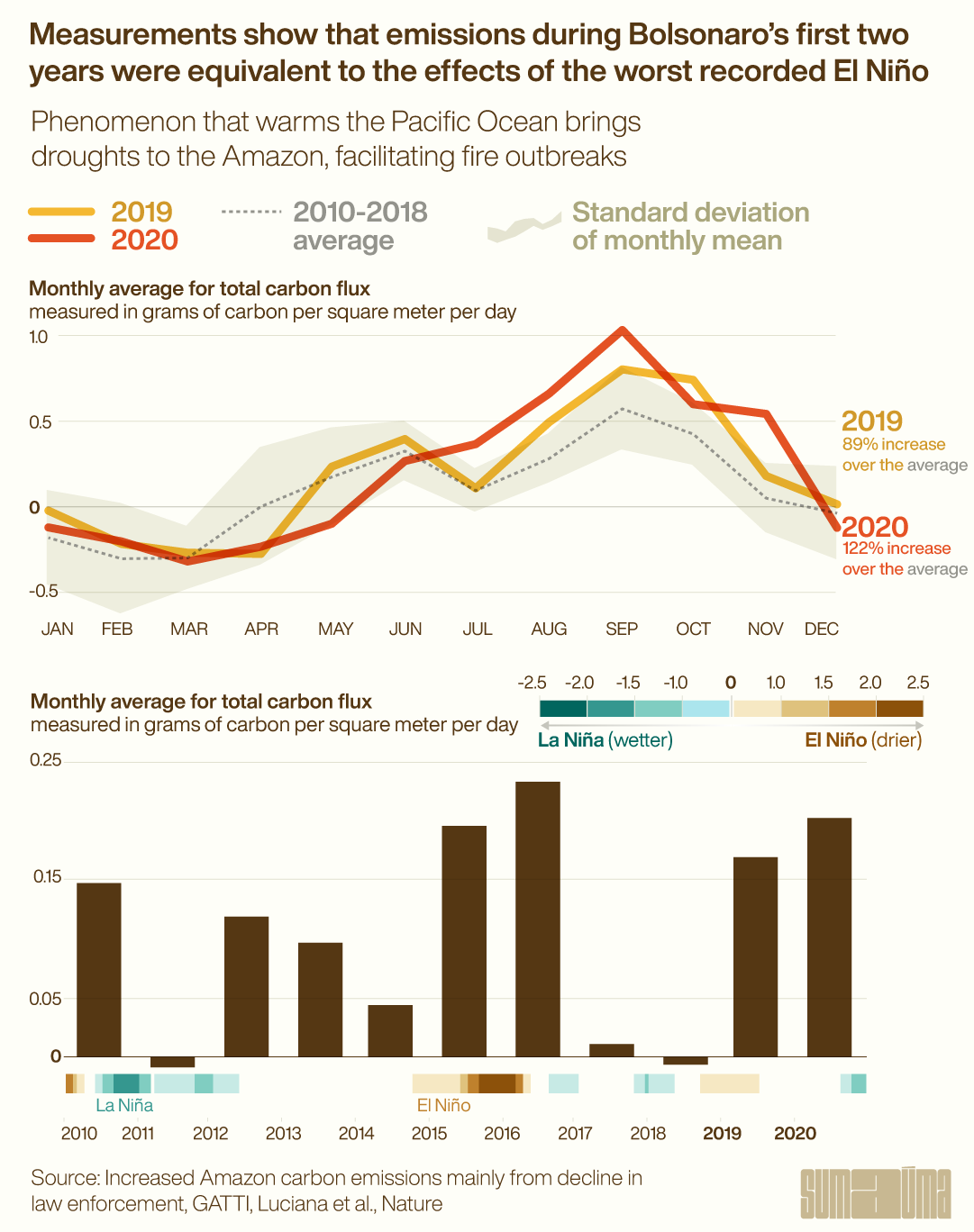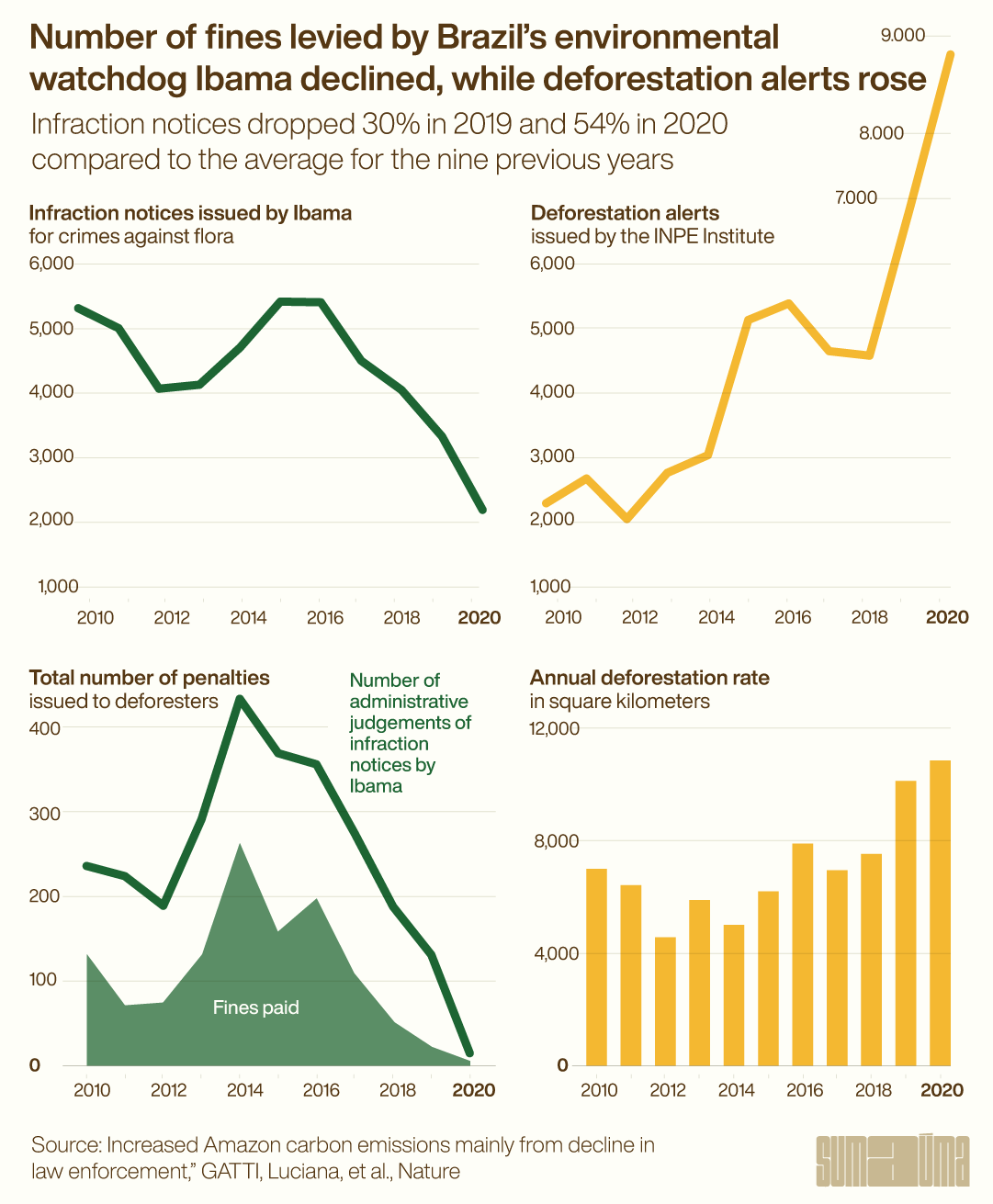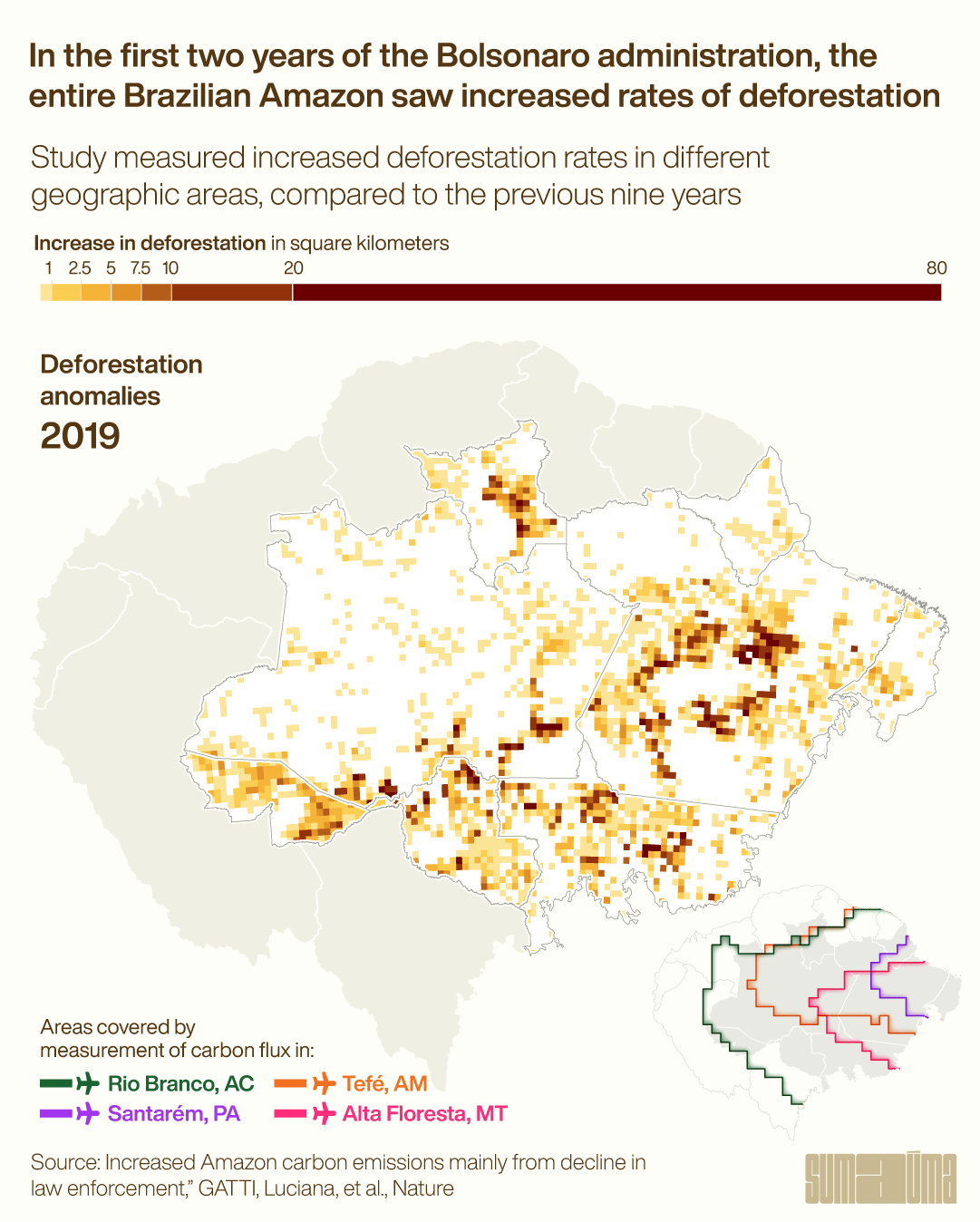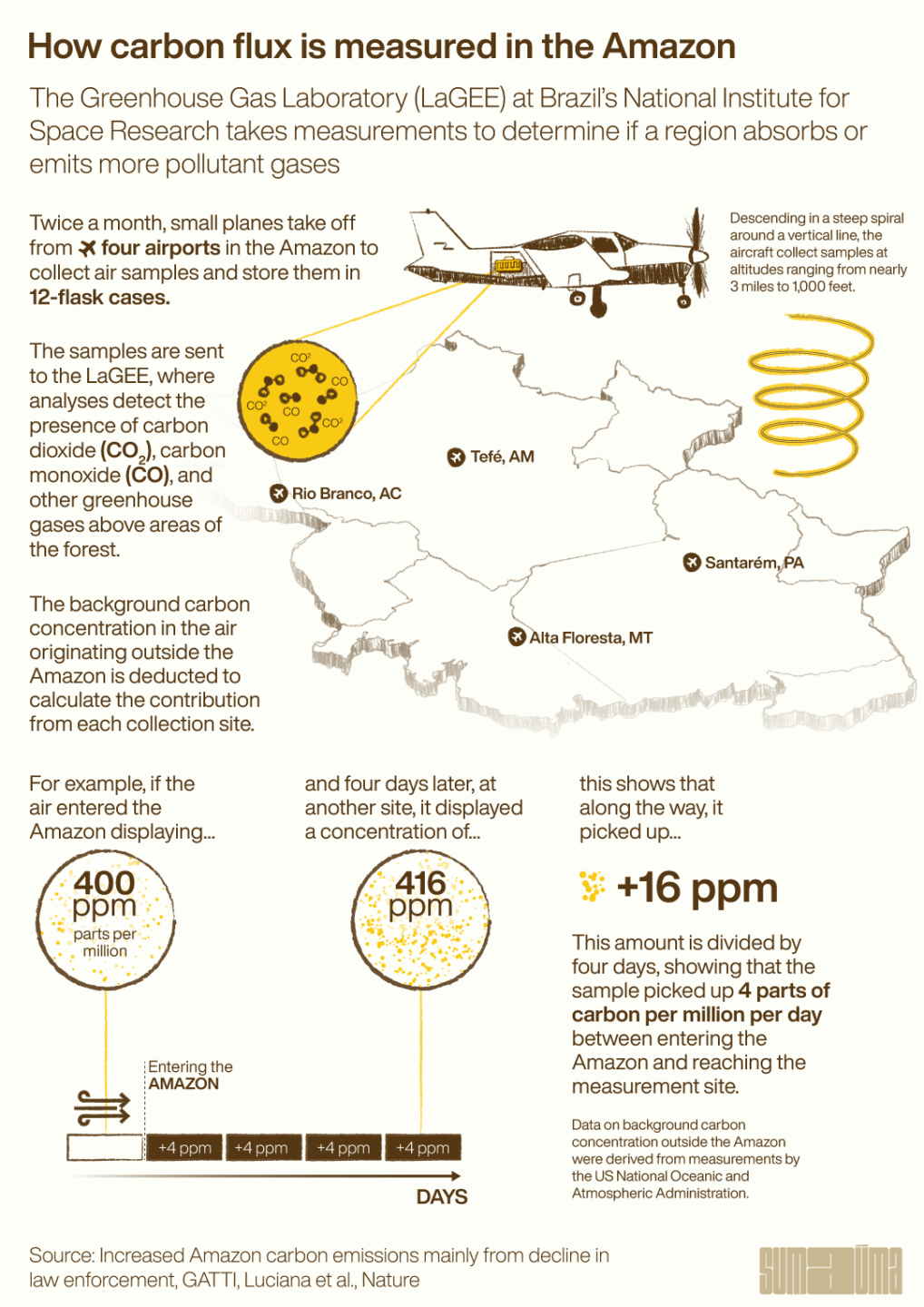Luciana Vanni Gatti is a scientist who is outraged by the destruction of the Amazon and by the people who refuse to see that razing the forest will have dire consequences for Brazil and the world. “My number one driving force is trying to open people’s minds to this,” says Gatti, coordinator of the Greenhouse Gas Laboratory at Brazil’s National Institute for Space Research, INPE. Gatti leads a group of investigators who were the first to show that the planet’s largest rainforest can no longer remove all the carbon dioxide—the prime culprit behind the greenhouse effect—that is released into the atmosphere over the Amazon by human activities such as deforestation and burn-offs. The journal Nature has just published the results of the most recent study headed by Gatti, which maps the “Bolsonaro effect”: mounting forest destruction in the Amazon. While the findings were discouraging, the scientist says there is still time to reverse the process. “If we can achieve zero burn-offs, zero deforestation, the Amazon will become a carbon sink,” she says, referring to the forest’s ability to absorb more greenhouse gas than the region releases.
A preliminary version of the article came out last September as a preprint, that is, prior to peer-review. Now the study has been endorsed by one of the most prestigious scientific journals in the world. The paper analyzes greenhouse gas emissions in the Amazon during 2019 and 2020, the first two years of far-right president Jair Bolsonaro’s administration. During this period, emissions closely approached those detected during the most extreme El Niño on record, in 2015 and 2016. The El Niño phenomenon, or warming of the Pacific Ocean, causes droughts and reduced precipitation in northern Brazil, promoting the spread of forest fires—and the burning of trees releases carbon into the atmosphere. “Bolsonaro and Ricardo Salles deserve the nickname ‘Brazilian El Niño’,” says Gatti, in a reference to Brazil’s former president and to his environment minister from January 2019 to June 2021.
Data collected by the Greenhouse Gas Laboratory show that emissions of carbon dioxide (CO2) and carbon monoxide (CO)—carbon-based greenhouse gases—rose 89% in 2019 and 122% in 2020 compared to the average recorded from 2010 to 2018. In general, this means that during the first two years of the Bolsonaro administration, the forest found it harder to absorb the carbon released into the air by human actions like deforestation and forest degradation—which is when only some trees are logged off or fire destroys just part of a standing forest.
Forest vegetation stores carbon during photosynthesis, the process that provides plants with nutrients. Carbon dioxide is first absorbed and then stored in leaves, trunks, and roots. When plants are uprooted, burned, or die, the carbon returns to the atmosphere. “The rainforest is not offsetting human damage,” the scientist explains.
In the absence of any extreme drought that could account for an increased incidence of fires and accordingly higher emissions in 2019 and 2020, Gatti’s research sought to link this increase to Bolsonaro’s policies. Other contributors to the study included colleagues from the Amazon Deforestation Monitoring Project (Prodes) and the Burn-offs Program (BDQueimadas), both part of the National Institute for Space Research; the National Disaster Surveillance & Early Warning Center (Cemaden); and the Universidade Federal de Minas Gerais team that monitors public policies in deforestation control. A total of 30 researchers signed the paper, entitled “Increased Amazon carbon emissions mainly from decline in law enforcement.”
The study calls attention to the decreased levying and collection of deforestation fines by Brazil’s environmental authority, Ibama. Under Bolsonaro, the enactment of a presidential decree (no. 9.760, of April 2019) and several Ibama rulings hampered enforcement of environmental regulations and made it easier for offenders to dodge fine payment. As a result, infraction notices dropped 30% in 2019 and 54% in 2020 compared to the average for 2010 to 2018. Fines paid slumped 74% in 2019 and 89% in 2020. Conversely, deforestation escalated 82% and 77%, while burned area grew 14% and 42% those same two years.
A symbolic milestone in forest destruction was so-called “Fire Day,” in 2019. On August 10 and 11 of that year, the National Institute for Space Research recorded 1,457 hot spots in Pará, with the epicenter in the city of Novo Progresso in the southwest of the state. This represented a 1,923% explosion compared to the same two days of the previous year, according to a survey by Greenpeace. On August 10, the region had 715 hot spots, 707% more than the previous day, when only 101 were detected. Police investigations showed that ranchers and farmers in Novo Progresso had passed the hat among themselves to buy fuel and set fire to the forest. The study by Greenpeace, however, reveals that fines were issued for only 5% of the 207 properties where fires had blazed.
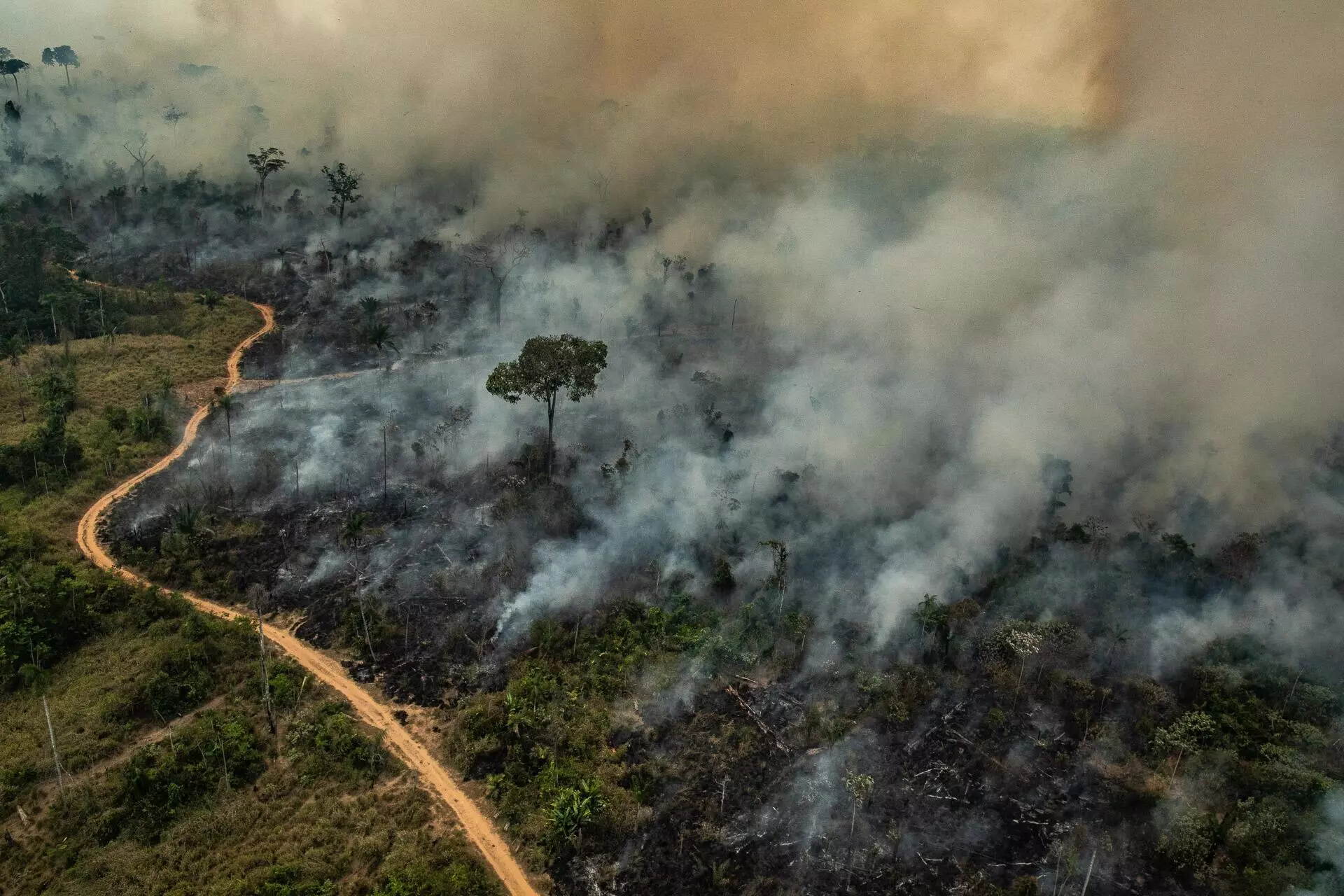
Aerial view of burn-offs in the region of Altamira, a municipality in the state of Pará, in 2019, under the administration of Jair Bolsonaro. Photo: Victor Moriyama/Greenpeace
In the wake of Fire Day, Bolsonaro faced international criticism for the increase in deforestation. He had a public spat with French president Emmanuel Macron, and Germany suspended donations to the Brazilian environmental sector. The fires were seen as an expression of support for Bolsonaro by the so-called ruralist bloc. In January 2022, at a Banco do Brasil event to launch a rural credit program, the former president hyped the shrinkage of fines during his administration. “We’ve stopped having big problems with the environmental issue, especially when it comes to fines. Do we have to have them? We do. But we talked it over, and we reduced fines in rural areas by over 80%,” he said. Seven months after Bolsonaro’s speech, on August 22, active burn-offs surpassed those of Fire Day: 3,358 across the Amazon, 1,126 of which in Pará.
The study published in Nature found that in 2019 and 2020 most of the increase in emissions was due to wildfires in standing forests, which has a prolonged effect on plant degradation. This is different from the usual “slash-and-burn,” where trees are first felled and then set afire. “Degradation was huge in 2019 and 2020,” says Gatti. “[Criminals] entered protected lands and Indigenous territories to take public land and burn living forest,” she says. “Since these fires burn underneath the forest cover, the satellite doesn’t pick them up well. When a fire goes out, carbon is still emitted because trees die and decompose. Emissions from decomposing plant matter exceeded emissions from forest fires,” she explains. Because it is so challenging to capture this type of destruction in real time, it makes sense that the increase in fire incidence detected during Bolsonaro’s first two years in office (3% in 2019 and 22% in 2020) was less than the increase in burned area.
The paper also offers data indicating subsequent use of the forest areas razed during those two years: The cattle population rose 13% in the Amazon during this two-year period while dipping 4% elsewhere in Brazil. Soybean planted area climbed 68% and corn, 58%. Exports of raw wood skyrocketed 683%. Following a February 2020 order issued by then Ibama head Eduardo Bim, the agency no longer required authorization of these exports, except for endangered tree species; for all non-endangered species, the exporter merely had to state that the wood had been legally sourced.
In 2021, the Federal Police investigated Bim and Ricardo Salles for alleged involvement in the illegal export of wood to the United States and Europe. By decision of Brazil’s Supreme Court, the Ibama president was removed from office for 90 days. Salles ended up losing his job, but last year he was elected federal deputy for São Paulo, representing the Liberal Party (PL). He garnered 640,000 votes, the fourth-largest win in the state’s lower house. The investigation is still ongoing.
The Domino Effect of Destruction
This is the third time Luciana Gatti has appeared as the first author of an article in Nature; the other two came out in 2014 and 2021. All three involve her research on the impact of the Amazon rainforest on regional and global climate and vice versa, because, just as the destruction of the Amazon influences the planet’s climate, climate change also harms the Brazilian forest. This line of research began in the 1990s, when the Earth scientist Carlos Nobre sought funding and partnerships abroad to establish the Large-Scale Biosphere-Atmosphere Experiment in Amazonia, or LBA, at the National Institute for Research on the Amazon (INPA). The LBA has helped train a generation of Brazilian scientists specialized in climate and environmental change, including Luciana Gatti. A chemist trained in the measurement of greenhouse gases, Gatti went on to study other areas, such as meteorology, in order to understand her findings.
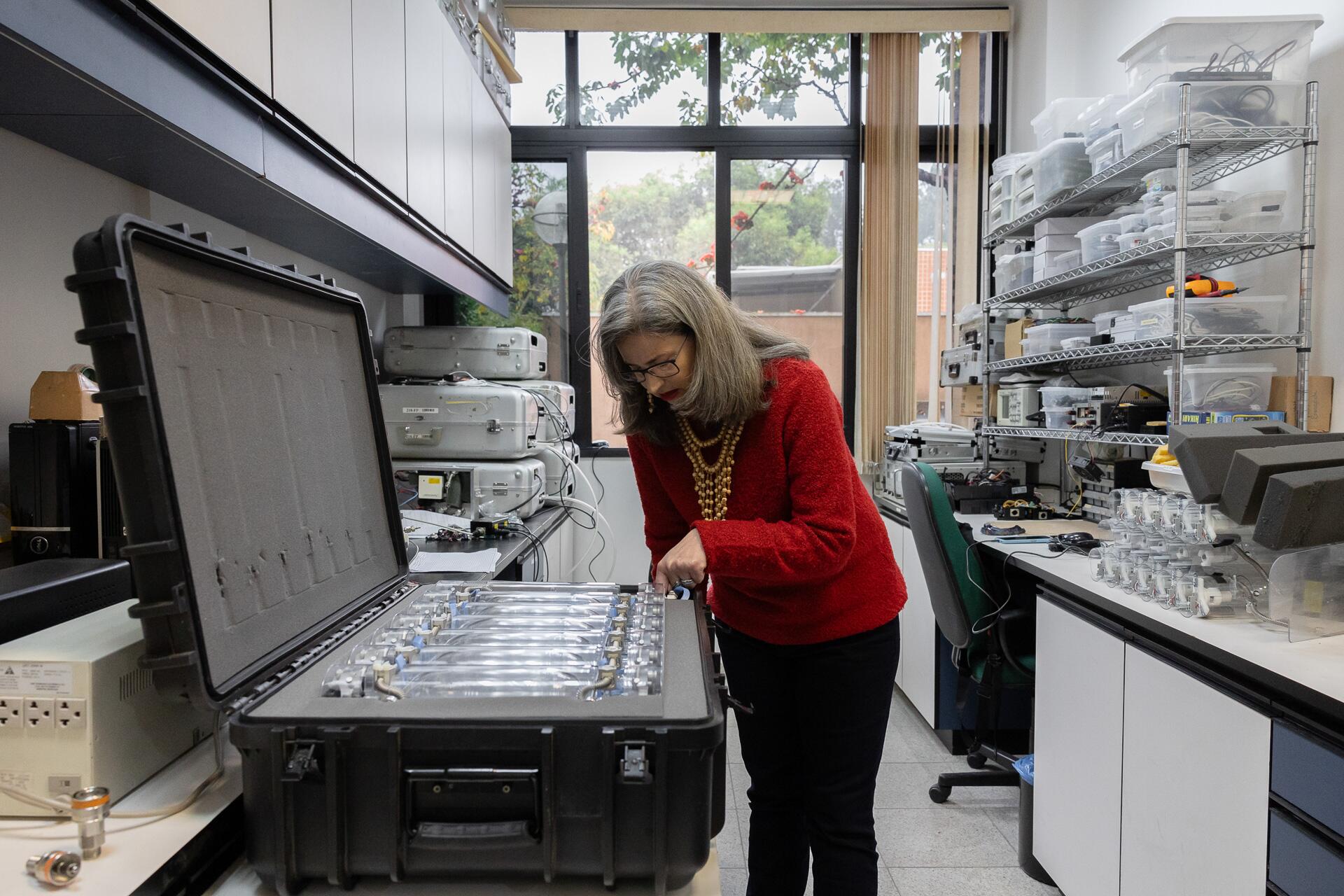
Luciana Gatti checks equipment used to collect air samples in the Amazon. Analyses are conducted at the National Institute for Space Research laboratory in São José dos Campos, in the state of São Paulo. Photo: Maíra Erlich/SUMAÚMA
The earliest measurements of the Amazon’s carbon balance—that is, whether the region emits or absorbs more of the gas—were made by collecting air samples from 262-foot-high towers. However, it was soon discovered that this form of data collection did not adequately represent the entire region, since the amount of carbon was only measured at one specific location.
This led to the idea of representing broader areas by using small planes to collect air samples in the Amazon at different distances from the soil, at altitudes ranging from 1,000 feet to nearly 3 miles, inspired by what was being done elsewhere by the US National Oceanic and Atmospheric Administration. The project came to fruition with the establishment of the Greenhouse Gas Laboratory, which took its first measurements in 2010 and today collects samples from four sites, representing the northeast, southeast, southwest, and northwest regions of the Brazilian Amazon. “If you descend and the concentration of CO2 declines, it means the surface is drawing CO2 out of the atmosphere. If it increases, it means the surface is a source—it’s emitting CO2,” Gatti explains. “This can tell you whether the Amazon is a carbon source or sink [absorbing more gas than it emits].”
In the article published in Nature in 2021, based on data from 2010 to 2018, the scientist had already stated that the Amazon forest was displaying a reduced capability to absorb all the carbon released into the region’s atmosphere. The paper showed that emissions were higher than absorption around Santarém, in Pará, and Alta Floresta, in Mato Grosso, both on the eastern side of the Amazon, historically more heavily deforested. At the time, the regions around Tefé, in Amazonas, and Rio Branco, in Acre, both in the western Amazon, were still absorbing more carbon than they released. In 2019, however, the area near Tefé became an emitter and in 2020 measurements taken near Rio Branco brought the same finding. “Deforestation has increased ridiculously in Mato Grosso, Rondônia, Roraima, southern Amazonas, and Acre,” says Gatti.
According to information from the Greenhouse Gas Laboratory, during only three of the eleven years running from 2010 to 2020 (2011, 2017, and 2018) was the carbon balance in the Amazon region as a whole neutral or negative, in other words, absorbing more than emitting on average. Emissions increased in 2010, although deforestation fell over the previous year, but there was another El Niño. Both 2011 and 2018 saw La Niñas, a phenomenon that has the opposite effect, cooling Pacific waters and bringing more rainfall to the Amazon.
Luciana Gatti, however, wasn’t entirely satisfied with the explanations she had for the carbon balance in the Amazon. While deforestation is a direct cause of increased carbon emissions, she was intrigued by the fact that there was no proportional relationship between accumulated deforestation and emissions. For example, a region that had lost 27% of its native woods was emitting eight times as much as an area where deforestation stood at 11%—instead of almost three times as much, as simple math would predict. Then came the study that afforded the “greatest lesson” in understanding how deforestation is modifying the remaining forest.
By analyzing 40 years’ worth of monthly rainfall and temperature data for each of the four regions covered by the lab’s samplings, Gatti ascertained that greater declines in precipitation and bigger rises in temperature occurred in the most heavily deforested areas, especially during the dry season. In the Amazon, this season corresponds to the months when the forest receives less water vapor from the ocean and the formation of rain depends more on tree transpiration or the evaporation of rivers. In more heavily deforested areas, there are fewer trees to offset the loss of rain.
A hotter dry season with lower rainfall “stresses” the forest, according to Gatti. In a stressed forest, more trees die and those that remain standing are more flammable. “The Amazon rainforest is like a game of dominoes, where everything is linked,” the scientist says. “When you deforest, you don’t just emit carbon; you reduce rainfall and increase temperatures, which will make the forest drier. When humans deforest and set fire [to an area that will be used for pastureland or crops], any forest that wasn’t cleared will be dry, and there will be many more fires,” she explains. “This set of scenarios explains emissions in the Amazon.”
The study recently published in Nature measured the impact of deforestation on temperature and precipitation during the first two years of the Bolsonaro administration. In 2019, there was no significant change over the average recorded for 2010-2018. In 2020, however, annual precipitation fell 12%. Unlike previous measurements, this decline was concentrated in January, February, and March, the wet season, which saw 26% less rain. In the same three months, the temperature climbed 0.6ºC. Less rainfall during the wet season will in turn impact the dry season, because less moisture will be available and the forest will catch fire more easily. “During the pandemic, I was alone, studying nonstop, and this is what began to emerge, this integrated vision of the destruction of the forest by idiotic, neanderthal Brazilians, who know nothing but the economic model from 50 years ago,” Gatti complains.

Lab coats and books on climate change in Luciana Gatti’s office at the National Institute for Space Research. Photo: Maíra Erlich/SUMAÚMA
The Forest and the World
Gatti emphasizes that the discouraging data found in her research must be viewed within a broader framework. While plant life in the Amazon—which represents about 50% of the world’s tropical rainforests—is under growing pressure, it still acts as a climate regulator, not only by absorbing carbon during photosynthesis but also through “evapotranspiration,” a process that releases water into the air in the form of vapor. This vapor is responsible for 50% of the recirculation of water in the Amazon itself and also produces rain in Brazil’s Central-West, Southeast, and South, where it is carried by the wind in a phenomenon known as flying rivers.
If the planet’s atmosphere hadn’t been altered by human activity, the carbon balance in the Amazon forest would be neutral, the scientist explains. “It’s a mature forest, and in a mature forest there is a balance between emission and absorption,” she says, pointing out that plant life also emits CO2 during respiration and decomposition. “But since the atmosphere is supercharged with carbon dioxide, nature is being encouraged to do more photosynthesis. This carbon absorption is not natural; it’s an imbalance caused by us.”
Gatti cites figures from the Global Carbon Project, an international scientific initiative that gauges the Global Carbon Budget. According to their calculations, the concentration of carbon dioxide in the atmosphere rose from 277 parts per million in the mid-eighteenth century, during the pre-industrial era, to 417 parts per million in 2022. And this is what is pushing up the planet’s average temperature and triggering the extreme weather events prompted by the increase, like prolonged droughts and atypical storms. Under these circumstances, the Amazon forest and other Brazilian ecosystems, such as the Pantanal, serve as a “climate buffer” for the country, Gatti says. When they evaporate water, they cool the atmosphere.
Over the last decade, an annual average of 35 billion metric tons of carbon was released worldwide from the burning of fossil fuels (oil, coal, and natural gas), with another 5 billion metric tons emitted as the result of land use changes, like deforestation. Of these total 40 billion metric tons, according to the Global Carbon Project, 19 billion stayed in the atmosphere, another 11 billion were absorbed by forests, and the remaining 10 billion by the oceans, a task performed by phytoplankton, formed of such organisms as algae, which also depend on photosynthesis. “If nature itself weren’t changing to offset the damage we’re doing, our situation would be much worse,” argues Gatti. “But how long will nature be able to do the job of cleaning up our mess?”
The study featured in Nature tries to offer a non-pessimistic conclusion about the future of the Amazon rainforest. It lists policies that led to a steady reduction of deforestation from 2004 through 2012, such as the first Action Plan for the Prevention and Control of Deforestation in the Legal Amazon (PPCDAm), introduced in 2004, and the implementation that same year of DETER, a satellite monitoring system that detects deforestation in near-real time. The paper also cites initiatives that have undermined surveillance, such as the Forest Code of 2012, which granted amnesty for 58% of all illegal deforestation through 2008 and gave landowners 20 more years to comply with the code. Likewise in 2018, under the Michel Temer administration, the Brazilian environmental agency stripped its field agents of the authority to destroy the equipment being used to destroy the forest.
Comparing the periods of 2010-2014 and 2016-2020, the study shows that during the latter four years, when the pace of deforestation picked up once again, Amazon emissions soared 50% while emissions released specifically by forest fires grew 16%. On the other hand, carbon absorption dropped 31%. According to the paper, this suggests that public policies are vital to preventing deforestation, forest degradation, and fires. Luciana Gatti calculates that if burn-offs and deforestation were halted, the forest would once again be able to offset the carbon dioxide launched into the atmosphere by human activity.
Gatti is already busy on a new research project, whose partners include Carnegie Science. Joseph Berry, a veteran scientist at the US institute, discovered that the compound known as COS, or carbonyl sulfide—formed of one atom each of carbon, oxygen, and sulfur—works as a “photosynthesis tracer.” Plants don’t differentiate between COS, which occurs naturally in the atmosphere, and carbon dioxide (CO2), so they absorb both when taking in nutrients. When plants breathe, however, they only produce CO2 and therefore do not return COS to the atmosphere. “The reduction of COS in air samples is proportional to photosynthesis,” Gatti explains. In other words, a reduction in COS in the air can provide a more accurate measure of how much CO2 plants absorb while consuming nutrients. “We will finally be able to tell whether forests that are more stressed by deforestation and rising temperatures are absorbing less carbon than well-preserved forests,” she says excitedly.
Fact check: Plínio Lopes
Spell check (Portuguese): Elvira Gago
Translation into Spanish: Julieta Sueldo Boedo
English translation: Diane Whitty
Photography editing: Lela Beltrão
Page setup: Érica Saboya
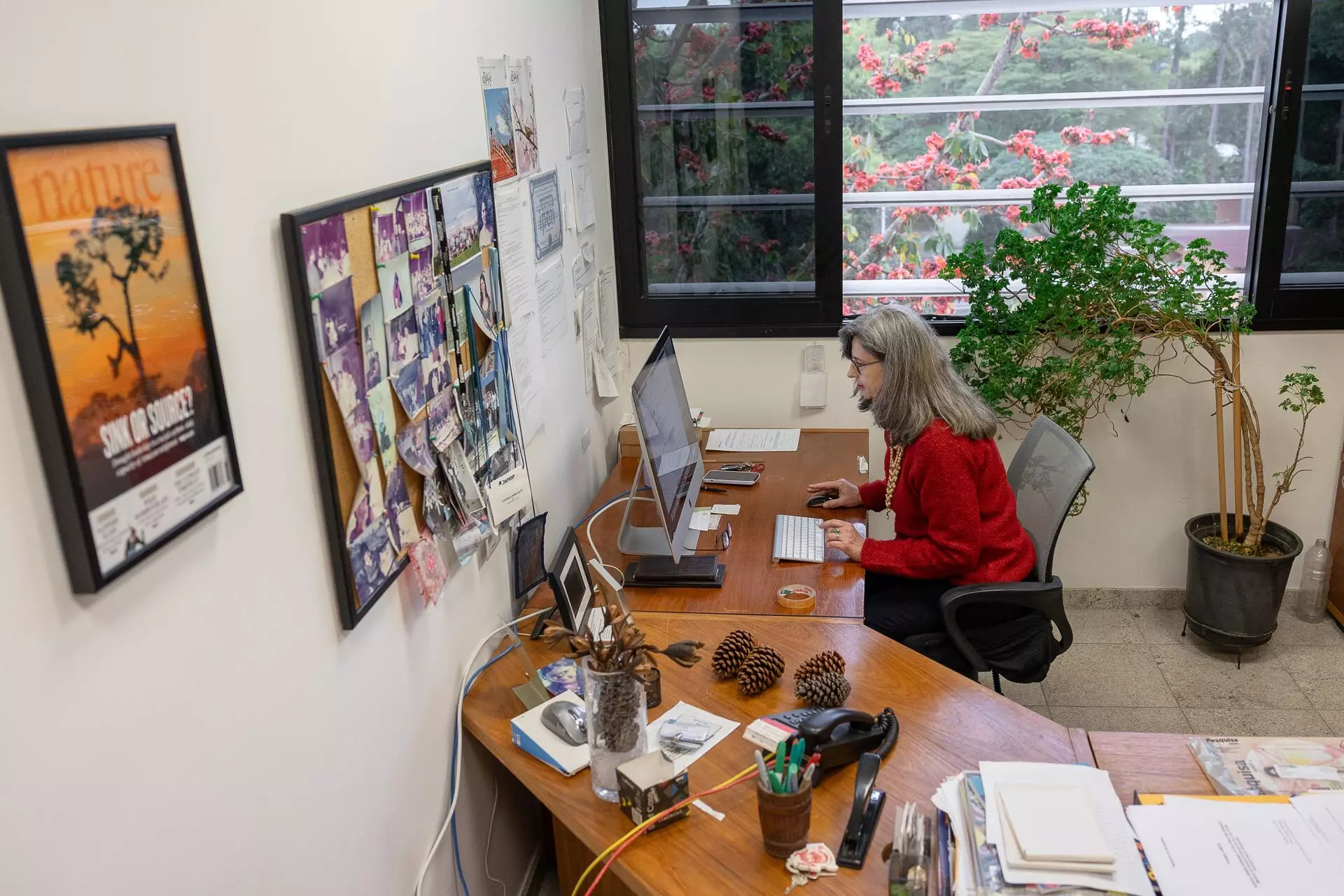
The scientist at her workplace. “We will finally be able to tell whether forests are being stressed by deforestation.” Photo: Maíra Erlich/SUMAÚMA




